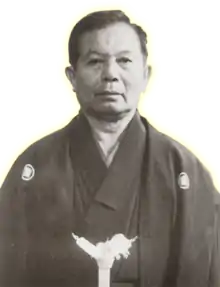Kanei Uechi
Kanei Uechi (上地完英[1], Uechi Kan'ei, June 26, 1911–February 23, 1991) was the son of Kanbun Uechi, founder of Uechi-Ryū, one of the primary karate styles of Okinawa. Kanei was instrumental in the growth of Uechi-Ryū after his father's death.
| Kanei Uechi | |
|---|---|
 Kanei Uechi | |
| Born | June 26, 1911 Okinawa |
| Died | February 23, 1991 (aged 79) |
| Native name | 上地 完英 Uechi Kanei |
| Style | Uechi-Ryū |
| Teacher(s) | Kanbun Uechi |
| Rank | Grandmaster 10th dan |
| Notable students | Seiko Toyama, Seiki Itokazu, Ryuko Tomoyose, Seiyu Shinjo, George Mattson (martial artist) |
Life
For the early years of Kanei's life his father, Kanbun Uechi refused to speak of his martial arts training. However, his father had once again begun teaching Pang-noon in 1926,[2] at the age of 16, and in ill-health, Kanei traveled to the Wakayama Prefecture and began training with his father.[3] After a decades worth of continuous training under Kanbun Uechi, in 1937 Kanei-Sensei received his certificate of full proficiency in Pangai-noon Toudi Jutsu (Tough-Flexible Method of Empty-Hand Skills). [4]
And later, at 26 he would open up a new dojo in Osaka with approval from Kanbun-Sensei.[5] Though, a new branch of Pangai-noon opened in Osaka, the dojo was not as successful as Kanei-Sensei hoped for. In 1940, Kanei relocated the dojo to Amagasaki in Hyogo Prefecture.[6] He taught there for two years before returning to Okinawa in 1942. In April of 1949, with the assistance of Ryuko Tomoyose, Uechi Kanei established the Nodake and Kanzatobaru dojo. The two schools would be combined in 1957 to form the first Futenma dojo.[5] A year later, Uechi-Ryū would open its doors to the public, including American G.I.'s,[5] becoming one of the first styles to teach Karate to foreigners.
When performing Sanchin, Kanei Uechi appeared deceivingly soft and relaxed. Upon closer inspection, his body was rock-solid and extremely tough.[7] In his youth, to condition his fingers, Kanei-Sensei would repeatedly thrust his hands into a banana tree using the nukite.[8] His fighting stance was extremely strong for defense. Kanei-Sensei favored fast wrist blocks with his left arm. While his right arm was effective for parrying punches and kicks.[9]
Additions to Uechi-Ryū
Kanei understood early that students of the modern age would have trouble understanding the formal Pangainoon and its three kata. From 1931 through the rest of his life Kanei labored to develop new methods and forms to help students understand Uechi-Ryū.[5][10] From this work came the addition of the warm-up and stretching exercises junbi undō (準備運動), the standardized exercises that incorporate elements of all of the kata of the system as well as additional techniques, two prearranged "yakusoku kumite (約束組み手)" exercises since students were getting injured from lack of control and sloppy fighting,[11] and three new "bridging" kata between Sanchin and Seisan and two between Seisan and Sanseiryu:
Kata
- Kanshiwa (完子和): A combination of the first kanji in Kanbun's name, and the last two kanji written in Chinese order of his teacher Zhou Zihe's name in Japanese pronunciation: "Shu Shiwa." Originally known as "Kanshabu" based on earlier mistranslation of his name into Japanese as "Shu Shabu."
- Kanshu (完周): A combination of the first kanji in Kanbun's name, and the kanji for Shu Shiwa's family name (Shu). Originally known as and sometimes still called Daini Seisan (第二十三) or "23rd."
- Seichin (十戦): Literally translated: "10 fights/conflicts," or a combination of the names of two of the original kata: Seisan and Sanchin.
- Seirui (十六): Literally translated: "16."
- Kanchin (完戦): A combination of Kanbun's first kanji 完 and "fight" 戦.
Family
Kanei Uechi is the son of Kanbun Uechi. Like his father, Kanei Uechi's mannerism and speech was with gentleness.[5][12] He was the oldest son of four children. He had a brother, Kansei, and two sisters, Tsuru and Kamai. Kanei had a son, Kanmei Uechi who was the head of the Uechi-Ryu Karate-Do Association until he died in 2015.[13][14]
References
- "Archived copy". Archived from the original on September 27, 2013. Retrieved August 3, 2012.CS1 maint: archived copy as title (link)
- Breyette, Seizan (2019-07-29). "Okinawa KarateDo UechiRyu Zankai History". Okinawa KarateDo UechiRyu Zankyokai Nagahama Dojo. Retrieved 2021-01-29.
- "Archived copy". Archived from the original on July 4, 2008. Retrieved September 17, 2008.CS1 maint: archived copy as title (link)
- "UechiRyu Zankai". urzk-nghm-dojo. Retrieved 2021-01-28.
- "History of Uechi RyuThe History of Uechi Ryu- Kanei Uechi". www.alandollar.com. Retrieved 2021-01-28.
- "Uechi Karate School of Allegan, Michigan-Detailed History". allegankarate.tripod.com. Retrieved 2021-01-28.
- Black Belt Magazine. July 1965. p. 15.
- Black Belt Magazine. June 1983. p. 82.
- Mattson, George (January 1, 1958). The Way of Karate. p. 174.
- "Archived copy". Archived from the original on July 4, 2008. Retrieved September 17, 2008.CS1 maint: archived copy as title (link)
- "G. Seizan Breyette - Reason for Yakusoku Kumite".
- Smith, David (May 27, 2012). Uechi Ryu Kartae Do Kyohan - Unofficial English Translation.
- "UECHI FAMILY -International Uechi-Ryu Karate-Do Shubukai". www.traditionaluechi-ryu.com. Retrieved 2021-01-29.
- "Koburyu – Koburyu Karate and Kobudo Lineage Chart". Retrieved 2021-01-29.
Further reading
- Bishop, Mark, Okinawan Karate, Tuttle: 1999
- Dollar, Alan, Secrets of Uechi Ryu and the Mysteries of Okinawa, Cherokee Publishing: 1996.
- Joyner, Donald B., Uechi Ryu Karate-Do Student Guide and Handbook (A Study Guide for Uechi Ryu Karate-Do), ISBN 978-1-304-90660-1, February 1996
- Mattson, George E., Uechiryu Karate Do (Classical Chinese Okinawan Self Defense), Peabody: 1997
- Rymaruk, Ihor, Karate: A Master's Secrets of Uechi-ryu, Iron Arm International: 2004.
- Compilers and authors: Uechi Kanei, Takamiyagi Shigeru, Nakamatsu Ken, Tōbaru Keichō, Yonamine Kōsuke, Seisetsu Okinawa Karate-do: Sono Rekishi to Giho, 1977 (Uechi Ryu Master Text/Kyohan)